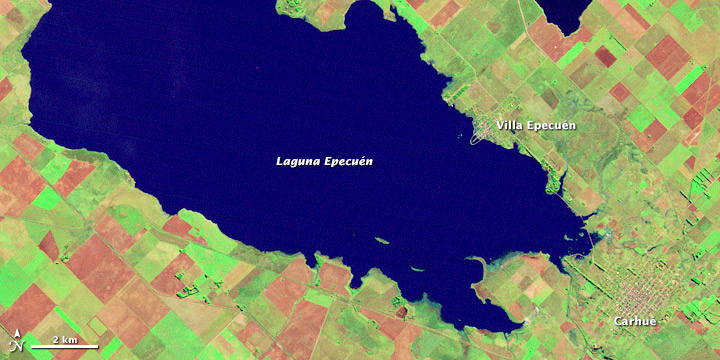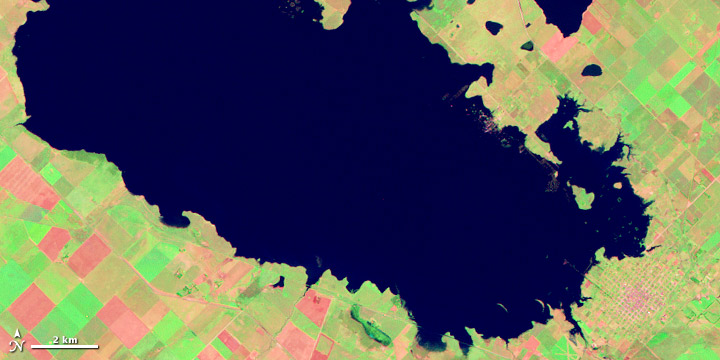NASA: Argentina - City Lost: Epecuen - 09.14.13
Posted by Ricardo Marcenaro | Posted in NASA: Argentina - City Lost: Epecuen - 09.14.13 | Posted on 16:54

acquired May 23, 1985
download large image (3 MB, JPEG, 2500x2500)
acquired May 23, 1985
download GeoTIFF file (12 MB, TIFF)

acquired February 3, 1986
download large image (3 MB, JPEG, 2500x2500)
acquired February 3, 1986
download GeoTIFF file (13 MB, TIFF)

acquired March 18, 1993
download large image (3 MB, JPEG, 2500x2500)
acquired March 18, 1993
download GeoTIFF file (13 MB, TIFF)

acquired June 5, 2013
download large image (2 MB, JPEG, 2500x2500)
acquired June 5, 2013
download GeoTIFF file (12 MB, TIFF)
acquired 1985 - 2013
download Google Earth file (KML)
Amidst the daily ups and downs of the
weather, we come to expect certain patterns: summer is warm, winter is
cold, deserts are dry, the tropics are wet. Single events—a heat wave or
a torrential downpour—may swing out of the norm but, for the most part,
we know what to expect.
However, sometimes there are kinks in this predictable
rhythm—multi-decadal variations in rainfall or temperature when “normal”
is not what it used to be. Epecuén, Argentina, recently experienced
such a multi-year swing.
In the 1920s, a resort town boomed on the shore of Lake Epecuén. The
lake is salty, and people found that soaking in its waters seemed to
have a restorative effect. Tourists flocked to the spa town for decades
until the climate began to get wetter in the 1980s. Lake Epecuén has no
outlet, so as more and more rain fell, the lake grew. After a
particularly severe storm on November 10, 1985, Lake Epecuén burst
through a dyke and flooded the town. Eventually, Epecuén was submerged
under 10 meters (33 feet) of salt water.
This series of false-color (shortwave infrared, red, and green) images from the Landsat satellites
captures the change in water levels that doomed the town. The 2013
image is from the Landsat 8 satellite and all of the other images are
from Landsat 5. Plant-covered land is green; bare or charred
agricultural fields are pink; and the exposed shoreline is tan.
The top image shows the town in 1985 when the dykes still held the
water back. In the next image (May 1986), the outline of Epecuén is
faintly visible beneath the water. An analysis of rain gauges revealed
an increase in rainfall starting in the mid-1970s. The wetter pattern
lasted until the early 2000s. The third image, from 1993, shows how the
lake grew throughout the wet period.
Drier conditions set in during the mid to late 2000s, including one of the worst droughts
Argentina had experienced in decades. At Lake Epecuén, evaporation and
warmer temperatures combined with a new series of canals to reduce water
levels. By 2013, the town of Epecuén had largely emerged as dry land,
its buildings in ruins and coated in salt. The tan ring around the lake
in the last image shows former water levels.
References
- The Age (2013, July 20) Atlantis of the pampas. Accessed August 14, 2013.
- Associated Press (2013, May 10) Creepy ghost town comes up for air. Accessed August 14, 2013.
- Daily Mail (2013, March 18). The town that drowned: Eerie pictures of the real life Atlantis that was underwater for 25 years. Accessed August 14, 2013.
NASA Earth Observatory images by Robert Simmon using Landsat data from the USGS EROS Data Center. Caption by Holli Riebeek. Rain gauge analysis by George Huffman.
- Instrument:
- Landsat 5
NASA: Argentina - City Lost: Epecuen - 09.14.13
Ricardo M Marcenaro - Facebook
Blogs in operation of The Solitary Dog:
Solitary Dog Sculptor:
http://byricardomarcenaro.blogspot.com
Solitary Dog Sculptor I:
http://byricardomarcenaroi.blogspot.com
Para:
comunicarse conmigo,
enviar materiales para publicar,
propuestas comerciales:
marcenaroescultor@gmail.com
For:
contact me,
submit materials for publication,
commercial proposals:
marcenaroescultor@gmail.com
My blogs are an open house to all cultures, religions and countries. Be a follower if you like it, with this action you are building a new culture of tolerance, open mind and heart for peace, love and human respect.
Thanks :)
Mis blogs son una casa abierta a todas las culturas, religiones y países. Se un seguidor si quieres, con esta acción usted está construyendo una nueva cultura de la tolerancia, la mente y el corazón abiertos para la paz, el amor y el respeto humano.
Gracias :)


Comments (0)
Publicar un comentario